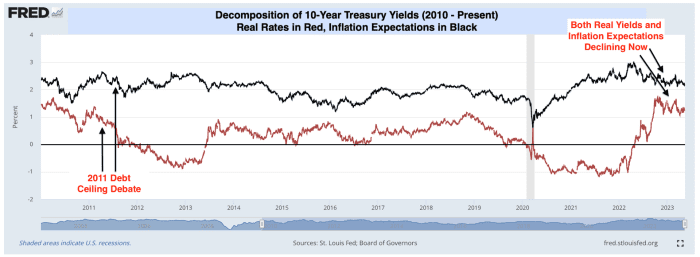Wall Street was watching as President Joe Biden said Wednesday that he is confident that the White House and congressional leaders would reach a deal on the debt ceiling.
One worry is that once a resolution is reached, the government could start to issue new debt, which might push Treasury yields higher, and in turn weigh on stocks.
But that isn’t likely to be the case, according to Nicholas Colas, co-founder of DataTrek Research, who based his argument on historical data, current trends in inflation expectations and real rates.
While analysts have been cutting their S&P 500 index SPX, +1.19% earnings estimates for the rest of the year, the market would need lower Treasury yields to support equity valuations at current levels, Colas said in a Wednesday note.
Heading into first-quarter earnings, he said Wall Street analysts cut estimates for second-quarter earnings by 7% to roughly $ 53.14 per share from $ 57.16.
The 10-year Treasury TMUBMUSD10Y, 3.568% yield was at 3.58% Wednesday, down about 25 basis points year-to-date, but still up almost 70 basis points from a year ago, according to Dow Jones Market Data.
Back in 2011, when a debt ceiling deal was reached between the Obama administration and the Republican majority in Congress, only at the last minute, both real yields and inflation expectations declined, which is shown in the chart below.

Both real yields of 10-Year Treasury and inflation expectations declined after an agreement was reached after the 2011 debt ceiling debate, but the Federal Reserve was buying government bonds.
St. Louis Fed
Real yields continued to drop in 2012 as the Fed continued expanding its holdings of Treasurys and other government-backed bonds. That isn’t expected to be the case in 2023 as the Fed squarely has tamping down inflation in focus, with a specific goal of getting it down to its 2% annual target.
Read: What happened to investments during the 2011 debt-ceiling crisis?
Recently, both inflation expectations and real yields have been declining from their 2022 highs in April of that year, and October of the same year, respectively, Colas noted.
Colas said he expects real rates to stabilize, as the Fed lets a set portion of its maturing Treasurys roll off its balance sheet each month, rather than adding to its $ 8.5 trillion balance sheet. “Inflation expectations should continue to drop, however, as the US economy slows,” Colas wrote.
“The net effect will be lower or, at worst, stable 10-year Treasury yields. With expectations for corporate earnings still dropping, it will be important for risk-free rates to stay stable or decline to offset diminishing future public company cash flows,” noted Colas.
Stocks closed higher Wednesday, with the S&P 500 up 1.2% at 4,148, the Dow Jones Industrial Average DJIA, +1.24% rose 1.2% and the Nasdaq Composite Index COMP, +1.28% gained 1.3%.
Read: Biden says ‘America will not default’ on U.S. debt
Also read: Debt-ceiling talks involve taking back unspent COVID funds: ‘It’s a nice hunk of change.’
